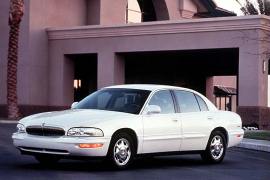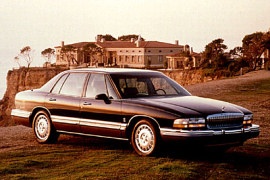BUICK Park Avenue Models/Series Timeline, Specifications & Photos
First production year: 1991
Engines: Gasoline
In 1997, the top volume luxury car in the U.S. was Buick. Its low-profile look, smooth ride, and reasonable prices placed it into the top, in front of other brands. In 1997, the Park Avenue was launched to keep the sales figures up.
The Park Avenue's platform was the new Platform G, which was an evolution of the C Platform, but more rigid. It was the same used on the Buick Riviera. The chromed grille was blamed to be too similar to a Jaguar.
From the outside, there were many similarities with the previous generation, but the headlights and the front bumper were different. The bumper-mounted turns signal was a good example. Large headlights and sidelights for lighting inside the curve was a good idea for that time. The car featured standard 16" light-alloy wheels with the Buick three-shield logo in the middle.
Inside, the luxurious sedan featured electrically adjustable front seats with fabric upholstery on the base model. The Ultra version though featured large leather seats. It had 10-way adjustable power seat, including the height-adjustable seatbelt that was mounted on the same arm with the headrest, instead of on the door as usual cars had it. As a luxury statement, Buick installed real wood trim on the dashboard and doors.
Under the hood, there were two engine options. Both were 3.8-liter V6, but with a supercharger for the Ultra version. The four-speed automatic transmission had a traction control button installed on the gear lever.
At the beginning of the '90s, Buick introduced a new lineup in its stable with the Park Avenue and Park Avenue Ultra models. The model was a new contender in the premium car market.
The Park Avenue had some design cues inspired by older Jaguar models. The front grille, the rounded lines, and the belt line were inspired by the Jaguar XJ line. The car maker insisted that the car was in the same league with the Jaguar XJ, Mercedes-Benz E 300 and the BMW 535i from that era, but the Park Avenue was considerably cheaper.
Due to its big size, the Park Avenue range featured a long wheelbase of 2.81 m (110.8”) that offered a sleek, elegant look for the vehicle. The rounded front and rear end and the curved roof line were some features that allowed a low drag coefficient.
Inside, the Park Avenue offered a luxurious interior, with leather seats and wood. It featured a dual-zone climate control, which was not that common in 1991. There were few buttons on the steering wheel. There was power everything, starting with the windows, the seats, and the sunroof. Since the car was front-wheel-drive and featured a big wheelbase, it offered plenty of room for the rear passengers.
Under the hood, there was the most important difference between the Park Avenue and the Ultra version. Both cars were fitted with a 3.8-liter V6, but only the Ultra featured a supercharger and it offered 40 more horsepower than the 200 hp, regular, Park Avenue. The standard transmission for both was a 4-speed automatic with overdrive.

